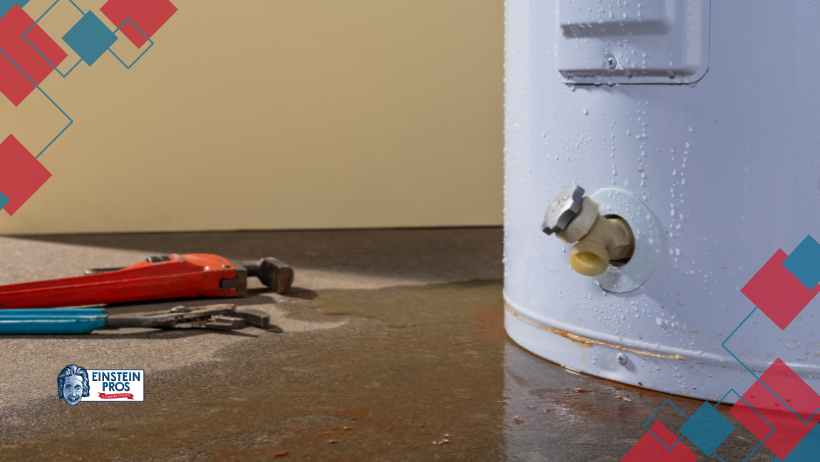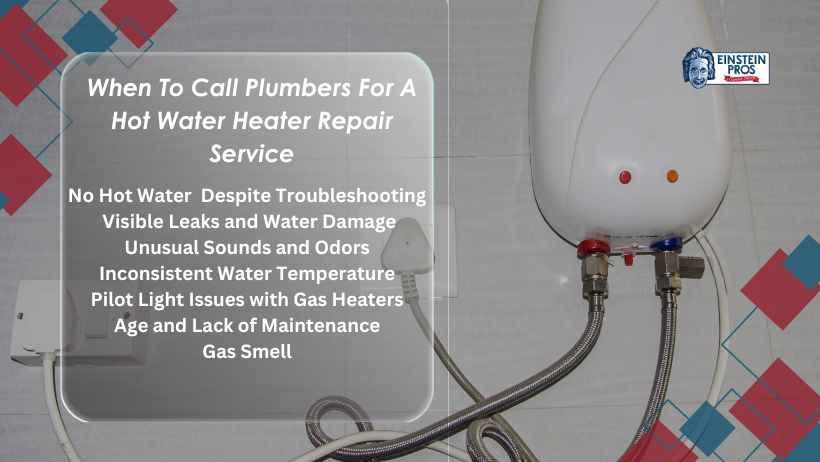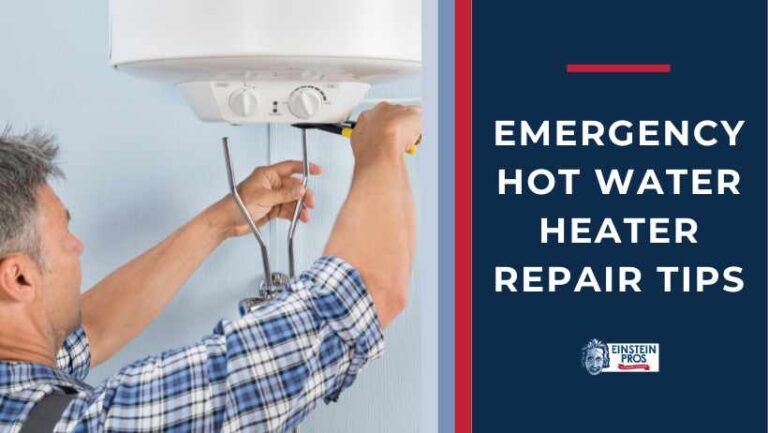Having a reliable water heater is essential for the comfort and functionality of any household. However, when issues arise unexpectedly, it’s crucial to address them promptly to avoid disruption to your daily activities. This comprehensive guide will walk you through the types of water heaters and key factors to consider when dealing with emergency hot water heater repair.
Types of Water Heaters
Water heaters come in various types, each designed to cater to different preferences, energy sources, and household needs. Understanding the distinctions between these types can help homeowners make informed decisions based on efficiency, space, and budget considerations.
1. Tank Water Heaters
Tank water heaters, also known as storage water heaters, are the most common type found in households. They consist of an insulated tank where water is heated and stored until it’s needed. These tanks typically range in size from 20 to 80 gallons, allowing homeowners to choose a capacity that suits their hot water demands. While they are generally less energy-efficient than other types, tank water heaters are cost-effective and relatively simple to install.
2. Tankless (On-Demand) Water Heaters
Tankless water heaters, or on-demand water heaters, heat water directly as it flows through the unit without the need for a storage tank. They are known for their energy efficiency since they only heat water when needed, avoiding standby heat loss associated with tank water heaters. Tankless heaters are more compact, making them an excellent choice for smaller spaces. However, the initial cost of installation is higher compared to traditional tank heaters. Tankless hot water heater repairs can also be more expensive but their advantages outweigh the cons depending on your home’s usage.
3. Heat Pump Water Heaters
Heat pump water heaters use electricity to move heat from the air or ground to heat the water. They are highly energy-efficient and can significantly reduce electricity consumption compared to traditional electric water heaters. Heat pump water heaters are most effective in warm climates, where they can efficiently extract heat from the air. While they may have a higher upfront cost, the long-term energy savings can make them a cost-effective option.
4. Solar Water Heaters
Solar water heaters harness energy from the sun to heat water. They consist of solar collectors, which are typically installed on the roof, and a system to transfer the heat to the water. There are two main types of solar water heaters: active systems, which use pumps to circulate water, and passive systems, which rely on gravity. While solar water heaters are environmentally friendly and can significantly reduce energy bills, they may require a backup heating system for cloudy days or high hot water demand.
5. Condensing Water Heaters
Condensing water heaters are designed to maximize energy efficiency by capturing and reusing heat from combustion gases. They have a secondary heat exchanger that extracts additional heat from the flue gases, allowing them to achieve higher efficiency levels compared to traditional gas water heaters. Condensing water heaters are typically more expensive upfront, but their energy savings over time can offset the initial investment.
6. Point-of-Use Water Heaters
Point-of-use water heaters are small, tankless units installed near the point of use, such as under sinks or in bathrooms. They provide hot water directly to a specific fixture, eliminating the need for hot water to travel through long pipes. Point-of-use water heaters are energy-efficient and ideal for supplementing the hot water supply in specific areas of the home. However, they are not suitable for meeting the hot water needs of an entire household.
How to Do an Emergency Hot Water Heater Repair
Knowing the specific steps for fixing your water heater is vital in case of emergencies. Remember that complicated situations require the expert assistance of experienced plumbers in Seattle.
1. Identification of the Problem
Lack of Hot Water
When confronted with a lack of hot water, it’s crucial to conduct a systematic investigation. Begin by checking the thermostat settings to ensure they align with your desired temperature. If the settings are correct, proceed to inspect the heating elements and thermostat for potential malfunctions. A malfunctioning thermostat may inaccurately regulate the temperature, leading to inadequate heating. Carefully examine for loose wiring or a faulty thermostat and replace it as needed.
Leaks and Drips
Water leakage around your water heater can result in serious damage if left unaddressed. Begin by visually inspecting the unit for visible leaks. Common culprits include a faulty pressure relief valve, a loose drain valve, or a crack in the tank. Getting help for leak problems promptly is essential to prevent water damage and ensure the longevity of your water heater.
Strange Noises
Unusual sounds emanating from your water heater are indicative of underlying issues. This may be caused by sediment buildup or a malfunctioning heating element. Flushing the tank to remove sediment and inspecting the heating elements can help resolve these concerns, restoring your hot water heater to optimal performance.
Inconsistent Water Temperature
Inconsistencies in water temperature can be traced back to a malfunctioning thermostat. Check for loose wiring or a faulty thermostat, ensuring it accurately regulates the water temperature. Addressing these issues promptly will ensure a steady and reliable supply of hot water in your household.
Pilot Light Issues
For gas-powered hot water heaters, pilot light issues can disrupt the heating process. Consult the manufacturer’s instructions to relight the pilot light or troubleshoot any issues related to its functionality. A properly functioning pilot light is essential for the efficient operation of gas water heaters.

2. Shutting Off the Power and Water Supply
Turn Off the Power
Ensuring safety is paramount when dealing with emergency hot water heater repairs. Begin by turning off the power supply to the hot water heater. Locate the circuit breaker or fuse dedicated to the heater and switch it off to prevent electric shock during the repair process.
Shut Off the Water Supply
Preventing further water damage is crucial, especially when dealing with leaks or water-related issues. Locate the shut-off valve connected to the hot water heater and turn it off. This precautionary measure will minimize potential damage and create a safer environment for repairs.
3. Assessing the Heating Element
Inspecting the Thermostat
The thermostat plays a critical role in regulating the temperature of your hot water heater. To identify malfunctions, use a multimeter to test the thermostat’s continuity. Replace the thermostat if necessary, ensuring it is set to the desired temperature to prevent overheating or inadequate heating.
Checking the Heating Elements
In electric hot water heaters, heating elements are prone to wear and tear. Use a multimeter to test the continuity of the elements. If they are faulty, replace them to restore the proper heating functionality of your hot water heater.
4. Addressing Leaks and Drips
Pressure Relief Valve
A leaking pressure relief valve is a common issue that can be resolved by replacing the faulty valve. Ensure that the replacement valve has the same pressure rating as the original to maintain the safety and efficiency of your hot water heater.
Drain Valve
If water is leaking from the drain valve, it may be loose or damaged. Tighten the valve or replace it if necessary to eliminate leaks and prevent water damage to the surrounding area.
Tank Inspection
A thorough inspection of the tank is essential when dealing with leaks. Look for visible cracks or signs of corrosion. If identified, it may be necessary to replace the entire hot water heater to prevent further damage and ensure the longevity of the system.
5. Flushing the Tank
Turn Off the Heater
Before flushing the tank, it’s crucial to turn off the power supply to the hot water heater. This prevents the heating elements from running without water, which could lead to damage.
Connect a Hose
Attach a garden hose to the drain valve located at the bottom of the tank. Ensure the other end of the hose leads to a suitable drain or disposal location to manage the flushed water.
Open the Drain Valve
Open the drain valve to allow sediment and debris to flush out of the tank. Monitor the water until it runs clear, indicating that the tank is free of sediment and debris.
Close the Drain Valve
Once the tank is flushed, close the drain valve securely. Remove the hose, and turn the power supply back on. This regular maintenance step helps prevent sediment buildup, ensuring the efficient operation of your hot water heater.
6. Replacing a Faulty Thermocouple
Turn Off the Gas Supply
For gas-powered hot water heaters, safety is paramount when replacing a faulty thermocouple. Turn off the gas supply to the heater to avoid any potential hazards during the repair process.
Remove the Access Panel
Access the thermocouple by opening the access panel near the burner assembly. Remove any insulation or covers obstructing the thermocouple for clear visibility.
Disconnect the Thermocouple
Using an adjustable wrench, carefully disconnect the thermocouple from the control valve. Take note of its position for accurate reinstallation later in the process.
Install the New Thermocouple
Attach the new thermocouple to the control valve, ensuring a secure and tight connection. Reassemble the access panel and insulation to protect the thermocouple from external elements.
Reassemble and Test
With the new thermocouple in place, reassemble the access panel, ensuring all components are securely fastened. Turn on the gas supply and relight the pilot light, testing the new thermocouple to ensure it operates efficiently.
7. Replacing a Faulty Heating Element
Turn Off the Power
Before proceeding to replace a faulty heating element, turn off the power supply to the hot water heater. This safety measure ensures a risk-free environment for the repair process.
Drain the Tank
To prevent water spillage during the heating element replacement, drain the tank following the steps outlined earlier. This precaution ensures a clean and safe workspace for the repair.
Remove the Access Panels
Open the access panels on the side of the hot water heater to expose the heating elements. Use a screwdriver to remove any screws securing the panels for easy access.
Disconnect Wires
Carefully disconnect the wires connected to the faulty heating element. Take a clear photograph or make detailed notes of the wiring configuration for accurate reconnection during the later stages of the repair.
Remove the Faulty Element
Using a heating element wrench, unscrew and remove the faulty heating element from the tank. Take care to avoid damaging the surrounding components during this process.
Install the New Element
Insert the new heating element into the tank and secure it with the heating element wrench. Reconnect the wires, ensuring they match the original configuration. Tighten all connections securely to prevent any electrical issues.
Test the Heater
With the new heating element in place, turn on the power supply and carefully monitor the hot water heater’s performance. Verify that the new heating element functions correctly, providing consistent and reliable hot water.
8. Checking the Anode Rod
Locate the Anode Rod
The anode rod plays a crucial role in preventing corrosion within the tank. Locate the anode rod by unscrewing the hex head located on top of the hot water heater.
Inspect the Anode Rod
Examine the anode rod for signs of corrosion or depletion. If the rod is heavily corroded or measures less than half an inch in thickness, it’s advisable to replace it promptly.
Replace the Anode Rod
Install a new anode rod by screwing it back into the hex head. This simple yet vital maintenance step helps prolong the life of your hot water heater by protecting the tank from corrosion.
9. Inspecting the Dip Tube
Identify the Dip Tube
The dip tube directs incoming cold water to the bottom of the tank for efficient heating. Identify the dip tube by removing the access panel located on the top of the hot water heater.
Check for Wear and Tear
Carefully inspect the dip tube for signs of wear, such as cracks or breakage. A damaged dip tube can compromise the efficiency of your hot water heater, leading to a reduced hot water supply.
Replace the Dip Tube
If the dip tube shows signs of wear or damage, replace it with a new one to ensure the proper distribution and heating of water within the tank. This straightforward maintenance step contributes to the overall efficiency of your water heater.
When To Call Plumbers For A Hot Water Heater Repair Service
Knowing when to call expert plumbers for “hot water heater repair near me” is crucial to prevent further damage, ensure safety, and restore hot water supply promptly. While some issues can be addressed with basic troubleshooting, certain situations warrant the expertise of professional plumbers.

1. No Hot Water in the House Despite Troubleshooting:
If you’ve checked the thermostat settings, ensured the power supply is on, and there are no visible leaks, but there is still no hot water in the house, it’s time to call in the experts. Complex issues, such as faulty heating elements or a malfunctioning gas control valve, require the skills of a trained plumber to diagnose and rectify. They may need to install a new water heater if the problem persists.
2. Visible Leaks and Water Damage:
Leaks around your hot water heater can lead to extensive water damage and compromise the integrity of your system. If you notice pooling water, dampness, or any signs of leakage, it’s crucial to seek professional assistance immediately. Expert plumbers can identify the source of the leak, whether it’s a faulty pressure relief valve, a loose connection, or a crack in the tank, and take the necessary steps to repair it.
3. Unusual Sounds and Odors:
Strange noises, such as popping or rumbling, coming from your hot water heater could indicate sediment buildup or a malfunctioning heating element. Additionally, if you detect unusual odors, especially a sulfur-like smell, it might be a sign of a gas leak. In both cases, it’s best to call in professional plumbers to inspect and address the issue, ensuring the safe and efficient operation of your hot water heater.
4. Inconsistent Water Temperature:
If your hot water heater produces water with inconsistent temperatures or if the water is scalding hot, the thermostat may be malfunctioning. Attempting to adjust or replace the thermostat without proper knowledge can lead to safety hazards. Professional plumbers have the expertise to troubleshoot and rectify thermostat-related issues, ensuring precise temperature control.
5. Pilot Light Issues with Gas Heaters:
For gas-powered hot water heaters, issues with the pilot light can disrupt the heating process. If you’ve followed the manufacturer’s instructions to relight the pilot light but continue to experience problems, it’s time to call in expert plumbers. They can assess the gas control valve, thermocouple, or other components to identify and address the root cause of the pilot light issues.
6. Age and Lack of Maintenance:
If your water heater is approaching the end of its typical lifespan (usually 8-12 years), and you haven’t performed regular maintenance, it’s wise to consult professional plumbers for a comprehensive inspection. They can assess the overall condition of the unit, identify potential issues, and recommend either repairs or replacement to avoid unexpected breakdowns.
7. Gas Smell:
A noticeable smell of gas near your hot water heater is a serious safety concern. Gas leaks can lead to hazardous situations, including fire or explosions. If you detect a gas odor, evacuate the premises immediately and contact your gas supplier. Once it’s safe, call expert plumbers to locate and repair the gas leak, ensuring the secure operation of your hot water heater.
Why Choose Einstein Pros For Your Water Heater Repair
When considering water heater repair, choosing the right service provider is paramount to ensure quality, efficiency, and customer satisfaction. Einstein Pros stands out as a reliable and trusted option for Seattle residents.
Einstein Pros brings a wealth of experience to the table. With years of proven expertise in water heater repair, our team of skilled professionals possesses in-depth knowledge of various types and brands of water heaters. Our plumbers can diagnose issues accurately, recommend effective solutions, and execute leak repairs, tune-ups, and maintenance efficiently, saving you both time and money.
Einstein Pros places a strong emphasis on customer satisfaction. Our commitment to delivering exceptional service is reflected in the positive reviews and testimonials from satisfied clients. By prioritizing customer needs and providing transparent communication throughout the repair process, Einstein Pros ensures that clients feel informed and confident in the service they receive.
Conclusion
Proactive maintenance and timely repairs by professional plumbers from Einstein Pros are essential for ensuring the continued efficiency of your water heater. By addressing emergency hot water heater repair in Seattle promptly and following the detailed steps outlined in this guide, you can maintain a reliable supply of hot water for your household. Prioritize safety by shutting off power and water supplies before attempting any repairs, and consider incorporating regular maintenance practices to prevent future emergencies.
